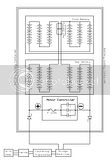Mr. Mik
1 kW
- Joined
- Sep 3, 2008
- Messages
- 390
I am wondering if a Variac like these ones: http://variac.com/staco_3PN10_20.htm could be connected to a battery through a bridge rectifier so that the Variac serves as a CV charger.
With the addition of some diodes it might be possible to have safe connections to the battery (which only allow charging but not discharging) and could be accessible outside of the battery safety container.
I'll try to make a diagram later on...is there anything fundamentally wrong with this concept?
With the addition of some diodes it might be possible to have safe connections to the battery (which only allow charging but not discharging) and could be accessible outside of the battery safety container.
I'll try to make a diagram later on...is there anything fundamentally wrong with this concept?


